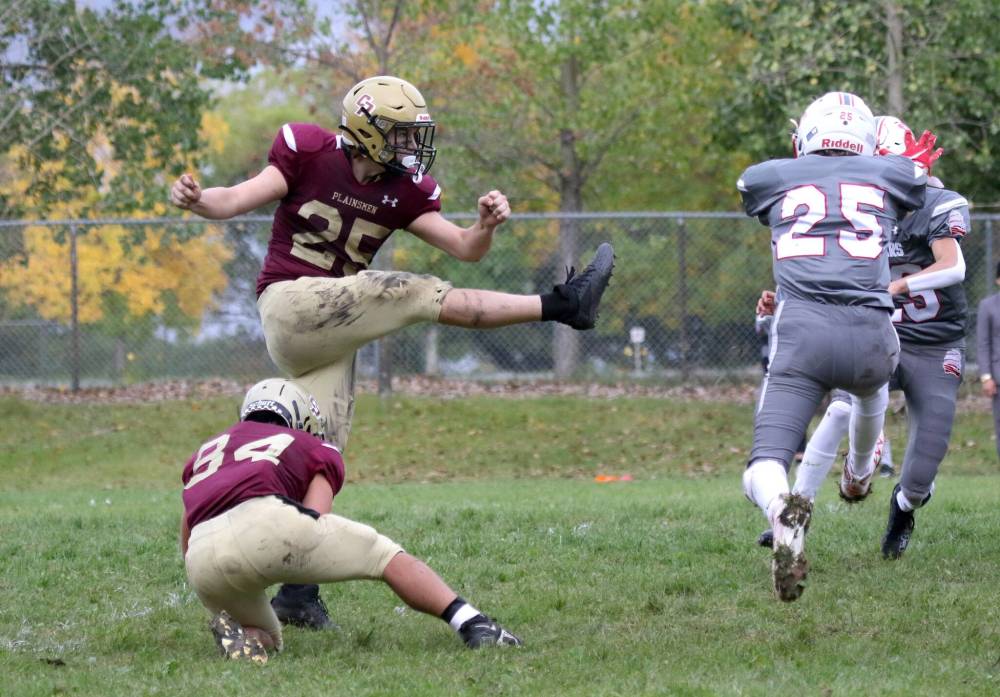‘We have to decide how profoundly we want that change to be all the way down’ No guarantee community-based teams in community-based facilities will adopt CFL changes
Read this article for free:
or
Already have an account? Log in here »
To continue reading, please subscribe:
Monthly Digital Subscription
$0 for the first 4 weeks*
- Enjoy unlimited reading on winnipegfreepress.com
- Read the E-Edition, our digital replica newspaper
- Access News Break, our award-winning app
- Play interactive puzzles
*No charge for 4 weeks then price increases to the regular rate of $19.00 plus GST every four weeks. Offer available to new and qualified returning subscribers only. Cancel any time.
Monthly Digital Subscription
$4.75/week*
- Enjoy unlimited reading on winnipegfreepress.com
- Read the E-Edition, our digital replica newspaper
- Access News Break, our award-winning app
- Play interactive puzzles
*Billed as $19 plus GST every four weeks. Cancel any time.
To continue reading, please subscribe:
Add Free Press access to your Brandon Sun subscription for only an additional
$1 for the first 4 weeks*
*Your next subscription payment will increase by $1.00 and you will be charged $16.99 plus GST for four weeks. After four weeks, your payment will increase to $23.99 plus GST every four weeks.
Read unlimited articles for free today:
or
Already have an account? Log in here »
While fans, players and coaches of the Canadian Football League come to terms with the major rule changes announced earlier this week, stakeholders across Canada’s amateur football landscape are wrestling with the potential ripples at the grassroots level.
The impact of the rule changes is expected to be felt at every level across Manitoba, particularly on the wallets of organizations.
The University of Manitoba Bisons are the highest level of amateur football in the province, playing in U Sports. Below them are the Winnipeg Rifles, who play under another national organization in the Canadian Junior Football League.

BROOK JONES / FREE PRESS
The University of Manitoba Bisons are just one of the university teams that share a stadium with a CFL club. U Sports CEO Pierre Arsenault said there may be a reality that two versions of fields will exist.
Then there are the exclusively local competitions, such as the Winnipeg High School Football League and Manitoba Minor Football Association, which will also need to confer with Football Manitoba and Football Canada in the ensuing months about the next course of action.
“It profoundly changes the game at the professional level. We have to decide how profoundly we want that change to be all the way down,” said executive director of Football Manitoba, Bill Johnson — who was not privy to the changes before Monday.
CFL commissioner Stewart Johnston sent waves across the country’s football sphere when he announced several major rule changes that will reshape Canadian football as it’s known over the next two years.
It will begin in 2026 with a modified version of the rouge — an exclusively Canadian rule — which will only award a single point when a punt or missed field goal is not returned out of the end zone, eliminating instances when teams kick a ball through the back or side of the end zone. The league will also institute a 35-second play clock that begins as soon as the previous play is whistled dead, and mandate that team benches must be on opposite sidelines.
The more transformative — and polarizing — changes come in 2027.
Fields will shrink from 110 yards to 100 yards in length — matching the distance of an American gridiron — and end zones will be reduced from 20 yards to 15 yards, while the goalposts move from the front to the back of end zones — another configuration that will be uniform with the U.S. game.
The 2027 changes will also be the most challenging of the bunch for amateur football organizations to adopt, owing to the major financial demand it presents for clubs, which often operate on tight budgets.
“If there’s an adoption of this field change, it’s a long-term process.”
“That’s something that we have to take into consideration, because our teams are community-based teams that play in community-based facilities,” said CJFL commissioner Jim Pankovich, who is on the Football Canada rules committee.
“If there’s an adoption of this field change, it’s a long-term process… and this isn’t going to happen in one or two years. This is probably a 10 or 15-year cycle for some of these facilities to be upgraded, if it’s chosen that it’s going to go that way.”
While there is a desire to align with the CFL, there is no guarantee that any amateur football leagues will adopt the rule changes.
From U Sports down, each league already has its own set of rules that are in place to prioritize the safety and development of athletes.
“We’re very proud of our connection to the CFL and to the significant number of youth sports players who find themselves being able to play professional football in the CFL… and want to see that continue,” said U Sports CEO Pierre Arsenault.
The CFL did not confer with U Sports about the potential changes and informed Canada’s university sports body about the shift a few hours before making the public announcement.
Arsenault said his organization does not have a deadline for when it will decide which changes to make. The first step is to take an inventory of which of its 27 football programs will be most impacted by the field changes and assess the time and cost it will take to build new infrastructure.
The Bisons, who play at Princess Auto Stadium, are one of four university programs in the country that share a stadium with a CFL franchise. The Regina Rams (share Mosaic Stadium with the Saskatchewan Roughriders), Calgary Dinos (share McMahon Stadium with the Calgary Stampeders) and McGill Redbirds (share Percival Molson Memorial Stadium with the Montreal Alouettes) are the others.
There are also a number of fields across the country, including the one in Winnipeg, that are used for other sports like soccer and rugby, which can complicate things further when U Sports makes its decision about whether to follow suit.
The decision for some facilities across the country could come down to whether their turf has lines stitched in or painted. If they are stitched, the cost to install a new field and move the goal posts can cost hundreds of thousands, maybe millions.
The average life cycle of a turf field is 10-15 years, which makes the timing of the announcement good for some schools and terrible for others.

Thomas Friesen / The Brandon Sun
Crocus Plainsmen Kendrick Breemersch kicks a field goal against the Kelvin Clippers during their Winnipeg High School Football League clash last week. At minor and high school levels, there is less concern about the size of the field but more talk about the cost of moving the goal posts back.
“Some schools are nine years in, some schools are going to replace next year. Some schools just replaced last year. And so we’ll have to understand all that,” Arsenault said. “To me, the conversation will ultimately come to how practical and acceptable — or livable — it is to run leagues in the immediate term in amateur football with both formats and play in a league.
“So if you arrive to a stadium or a field that has the new CFL format, you play the game that way, and if you arrive to a field that has the existing format, then you play the game that way, because you know that’s probably going to be the reality in the near term is (that) both fields exist in Canada.”
The timing is tough for several facilities in Winnipeg, including the Fort Garry Lions Football Club, which installed a new turf field with the current field specs earlier this month, and the St. Vital Mustangs Football Club, which installed new turf last year. The turf at the East Side Eagles Football Club is expected to be redone in 2026.
At the minor and high school levels, there is less concern about the size of the field and more talk about the cost of moving the goal posts back. Field sizes in the MMFA are already smaller in younger divisions, but while field goals are already rare, moving the goal posts back would make the three-point attempt nearly obsolete.
“I guarantee you, Wade (Miller, Winnipeg Blue Bombers president and CEO) has already thought about how he’s going to help us. I know he’s got a plan, and he’s always taking care of us,” said WHSFL commissioner Jeffrey Bannon.
Bannon said he would’ve appreciated more communication from the CFL on the rule changes, but that he trusts Johnston and the CFL’s board of governors.
“I’m not losing any sleep over this. I’m actually more excited than I am nervous about these new changes.”
“I’m not losing any sleep over this. I’m actually more excited than I am nervous about these new changes,” he said.
Maintaining his positive mindset, Bannon noted that there is a lack of consistency among the fields that high school teams play on currently. Shrinking them would allow for more uniformity across the league.
“It also now allows us to go after, hopefully, some civic and federal and provincial money to get some more fields, because I believe Manitoba has the least amount of turf fields (of any province) across the country,” he said.
Football Manitoba and its stakeholders are expected to hold a meeting in December, after the high school and CFL seasons have concluded, to determine next steps.
“We’re excited,” Bannon said. “The game is still staying Canadian. The 65 yards, the three downs, the balls are bigger, the motion, the waggle, the rouge — I still think that, at the end of the day, this is for the betterment.
“We’re not going to lose any high school kids playing football because of these. We’re going to gain.”
joshua.frey-sam@freepress.mb.ca
X: @jfreysam

Josh Frey-Sam reports on sports and business at the Free Press. Josh got his start at the paper in 2022, just weeks after graduating from the Creative Communications program at Red River College. He reports primarily on amateur teams and athletes in sports. Read more about Josh.
Every piece of reporting Josh produces is reviewed by an editing team before it is posted online or published in print — part of the Free Press‘s tradition, since 1872, of producing reliable independent journalism. Read more about Free Press’s history and mandate, and learn how our newsroom operates.
Our newsroom depends on a growing audience of readers to power our journalism. If you are not a paid reader, please consider becoming a subscriber.
Our newsroom depends on its audience of readers to power our journalism. Thank you for your support.




